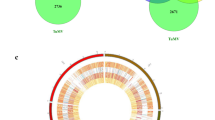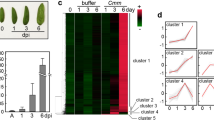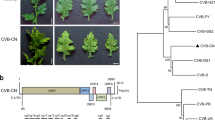Abstract
The chrysanthemum is one of popular flowers in the world and a host for several viruses. So far, molecular interaction studies between the chrysanthemum and viruses are limited. In this study, we carried out a transcriptome analysis of chrysanthemum in response to three different viruses including Cucumber mosaic virus (CMV), Tomato spotted wilt virus (TSWV) and Potato virus X (PVX). A chrysanthemum 135K microarray derived from expressed sequence tags was successfully applied for the expression profiles of the chrysanthemum at early stage of virus infection. Finally, we identified a total of 125, 70 and 124 differentially expressed genes (DEGs) for CMV, TSWV and PVX, respectively. Many DEGs were virus specific; however, 33 DEGs were commonly regulated by three viruses. Gene ontology (GO) enrichment analysis identified a total of 132 GO terms, and of them, six GO terms related stress response and MCM complex were commonly identified for three viruses. Several genes functioning in stress response such as chitin response and ethylene mediated signaling pathway were up-regulated indicating their involvement in establishment of host immune system. In particular, TSWV infection significantly down-regulated genes related to DNA metabolic process including DNA replication, chromatin organization, histone modification and cytokinesis, and they are mostly targeted to nucleosome and MCM complex. Taken together, our comparative transcriptome analysis revealed several genes related to hormone mediated viral stress response and DNA modification. The identified chrysanthemums genes could be good candidates for further functional study associated with resistant to various plant viruses.





Similar content being viewed by others
References
Afzal AJ, Wood AJ, Lightfoot DA (2008) Plant receptor-like serine threonine kinases: roles in signaling and plant defense. Mol Plant Microbe Interact 21:507–517. doi:10.1094/MPMI-21-5-0507
Agrawal GK, Rakwal R, Tamogami S, Yonekura M, Kubo A, Saji H (2002) Chitosan activates defense/stress response (s) in the leaves of Oryza sativa seedlings. Plant Physiol Biochem 40:1061–1069. doi:10.1016/S0981-9428(02)01471-7
Ambrose JC, Cyr R (2007) The kinesin ATK5 functions in early spindle assembly in Arabidopsis. Plant Cell 19:226–236. doi:10.1105/tpc.106.047613
An J, Song A, Guan Z, Jiang J, Chen F, Lou W, Fang W, Liu Z, Chen S (2014) The over-expression of Chrysanthemum crassum CcSOS1 improves the salinity tolerance of chrysanthemum. Mol Biol Rep 41:4155–4162. doi:10.1007/s11033-014-3287-2
Ascencio-Ibáñez JT, Sozzani R, Lee T-J, Chu T-M, Wolfinger RD, Cella R, Hanley-Bowdoin L (2008) Global analysis of Arabidopsis gene expression uncovers a complex array of changes impacting pathogen response and cell cycle during geminivirus infection. Plant Physiol 148:436–454. doi:10.1104/pp.108.121038
Blüthgen N, Brand K, Čajavec B, Swat M, Herzel H, Beule D (2005) Biological profiling of gene groups utilizing gene ontology. Genome Inform 16:106–115
Bruce TJ, Matthes MC, Napier JA, Pickett JA (2007) Stressful “memories” of plants: evidence and possible mechanisms. Plant Sci 173:603–608. doi:10.1016/j.plantsci.2007.09.002
Caillaud M-C, Paganelli L, Lecomte P, Deslandes L, Quentin M, Pecrix Y, Le Bris M, Marfaing N, Abad P, Favery B (2009) Spindle assembly checkpoint protein dynamics reveal conserved and unsuspected roles in plant cell division. PLoS ONE 4:e6757. doi:10.1371/journal.pone.0006757
Catoni M, Miozzi L, Fiorilli V, Lanfranco L, Accotto GP (2009) Comparative analysis of expression profiles in shoots and roots of tomato systemically infected by Tomato spotted wilt virus reveals organ-specific transcriptional responses. Mol Plant Microbe In 22:1504–1513. doi:10.1094/MPMI-22-12-1504
Chen S, Miao H, Chen F, Jiang B, Lu J, Fang W (2009) Analysis of expressed sequence tags (ESTs) collected from the inflorescence of Chrysanthemum. Plant Mol Biol Report 27:503–510. doi:10.1007/s11105-0009-0103-6
Chinnusamy V, Zhu J-K (2009) Epigenetic regulation of stress responses in plants. Curr Opin Plant Biol 12:133–139. doi:10.1016/j.pbi.2008.12.006
Cho WK, Jo Y, Jo K-M, Kim K-H (2013) A current overview of two viroids that infect chrysanthemums: Chrysanthemum stunt viroid and Chrysanthemum chlorotic mottle viroid. Viruses 5:1099–1113. doi:10.3390/v5041099
Conesa A, Götz S, García-Gómez JM, Terol J, Talón M, Robles M (2005) Blast2GO: a universal tool for annotation, visualization and analysis in functional genomics research. Bioinformatics 21:3674–3676. doi:10.1093/bioinformatics/bti610
Courtney-Gutterson N, Napoli C, Lemieux C, Morgan A, Firoozabady E, Robinson KE (1994) Modification of flower color in florist’s Chrysanthemum: production of a white-flowering variety through molecular genetics. Nat Biotech 12:268–271. doi:10.1038/nbt0394-268
Dang HQ, Tran NQ, Gill SS, Tuteja R, Tuteja N (2011) A single subunit MCM6 from pea promotes salinity stress tolerance without affecting yield. Plant Mol Biol 76:19–34. doi:10.1007/s11103-011-9758-0
Ding L, Chen FD, Teng NJ, Fang WM (2008) Analysis of genetic diversity of cultivars in Dendranthema × grandiflorum based on POD and SOD isozyme. Scientia Agricultura Sinica 4:027
Fu J, Wang L, Wang Y, Yang L, Yang Y, Dai S (2014) Photoperiodic control of FT-like gene ClFT initiates flowering in Chrysanthemum lavandulifolium. Plant Physiol Biochem 74:230–238. doi:10.1016/j.plaphy.2013.11.004
García-Marcos A, Pacheco R, Martiáñez J, González-Jara P, Díaz-Ruíz JR, Tenllado F (2009) Transcriptional changes and oxidative stress associated with the synergistic interaction between Potato virus X and Potato virus Y and their relationship with symptom expression. Mol Plant Microbe Interact 22:1431–1444. doi:10.1094/MPMI-22-11-1431
Gu C, Chen S, Liu Z, Shan H, Luo H, Guan Z, Chen F (2011) Reference gene selection for quantitative real-time PCR in Chrysanthemum subjected to biotic and abiotic stress. Mol Biotechnol 49:192–197
Hanley-Bowdoin L, Settlage SB, Orozco BM, Nagar S, Robertson D (1999) Geminiviruses: models for plant DNA replication, transcription, and cell cycle regulation. Crit Rev Plant Sci 18:71–106. doi:10.1080/07352689991309162
Hanley-Bowdoin L, Bejarano ER, Robertson D, Mansoor S (2013) Geminiviruses: masters at redirecting and reprogramming plant processes. Nat Rev Microbiol 11:777–788. doi:10.1038/nrmicro3117
He H, Yajing N, Huawen C, Xingjiao T, Xinli X, Weilun Y, Silan D (2012) cDNA-AFLP analysis of salt-inducible genes expression in Chrysanthemum lavandulifolium under salt treatment. J Plant Physiol 169:410–420. doi:10.1016/j.jplph.2011.09.013
Hitmi A, Coudret A, Barthomeuf C (2000) The production of pyrethrins by plant cell and tissue cultures of Chrysanthemum cinerariaefolium and Tagetes species. Crit Rev Biochem Mol Biol 35:317–337. doi:10.1080/07352680091139187
Holding DR, Springer PS (2002) The Arabidopsis gene PROLIFERA is required for proper cytokinesis during seed development. Planta 214:373–382. doi:10.1007/s00425-0001-0686-0
Irizarry RA, Bolstad BM, Collin F, Cope LM, Hobbs B, Speed TP (2003) Summaries of Affymetrix GeneChip probe level data. Nucl Acids Res 31:e15–e15
Jo Y, Jo K-M, Park S-H, Kim K-H, Cho WK (2014) Transcriptomic landscape of chrysanthemums infected by Chrysanthemum stunt viroid. Plant Omics 7:1–11
Journot-Catalino N, Somssich IE, Roby D, Kroj T (2006) The transcription factors WRKY11 and WRKY17 act as negative regulators of basal resistance in Arabidopsis thaliana. Plant Cell 18:3289–3302. doi:10.1105/tpc.106.044149
Lang Q, Jin C, Gao X, Feng J, Chen S, Lai L, Chen J (2011) Profiling of Cucumber Mosaic Virus responsive mRNAs in tomato using Paraflo microfluidics microarrays. J Nanosci Nanotech 11:3115–3125. doi:10.1166/jnn.2011.3860
Li R, Murray AW (1991) Feedback control of mitosis in budding yeast. Cell 66:519–531
Li T, Je Guo, Li Y, Ning H, Sun X, Zheng C (2013) Genetic diversity assessment of chrysanthemum germplasm using conserved DNA-derived polymorphism markers. Sci Hort 162:271–277. doi:10.1016/j.scienta.2013.08.027
Li H, Chen S, Song A, Wang H, Fang W, Guan Z, Jiang J, Chen F (2014) RNA-Seq derived identification of differential transcription in the chrysanthemum leaf following inoculation with Alternaria tenuissima. BMC Genomic 15:9. doi:10.1186/1471-2164-15-9
Liang W, Li C, Liu F, Jiang H, Li S, Sun J, Wu X, Li C (2008) The Arabidopsis homologs of CCR4-associated factor 1 show mRNA deadenylation activity and play a role in plant defence responses. Cell Res 19:307–316. doi:10.1038/cr.2008.317
Licausi F, Ohme-Takagi M, Perata P (2013) APETALA2/ethylene responsive factor (AP2/ERF) transcription factors: mediators of stress responses and developmental programs. New Phytol 199:639–649. doi:10.1111/nph.12291
Liu P-L, Wan Q, Guo Y-P, Yang J, Rao G-Y (2012) Phylogeny of the genus Chrysanthemum L.: evidence from single-copy nuclear gene and chloroplast DNA sequences. PLoS ONE 7:e48970. doi:10.1371/journal.pone.0048970
Liu P, Chen S, Song A, Zhao S, Fang W, Guan Z, Liao Y, Jiang J, Chen F (2014) A putative high affinity phosphate transporter, CmPT1, enhances tolerance to Pi deficiency of chrysanthemum. BMC Plant Biol 14:18. doi:10.1186/1471-2229-14-18
Lu J, Du Z-X, Kong J, Chen L-N, Qiu Y-H, Li G-F, Meng X-H, Zhu S-F (2012) Transcriptome analysis of Nicotiana tabacum infected by Cucumber mosaic virus during systemic symptom development. PLoS ONE 7:e43447. doi:10.1371/journal.pone.0043447
Marathe R, Guan Z, Anandalakshmi R, Zhao H, Dinesh-Kumar S (2004) Study of Arabidopsis thaliana resistome in response to Cucumber mosaic virus infection using whole genome microarray. Plant Mol Biol 55:501–520. doi:10.1007/s11103-004-0439-0
Meyer K, Leube MP, Grill E (1994) A protein phosphatase 2C involved in ABA signal transduction in Arabidopsis thaliana. Science 264:1452–1455. doi:10.1105/tpc.9.5.759
Miya A, Albert P, Shinya T, Desaki Y, Ichimura K, Shirasu K, Narusaka Y, Kawakami N, Kaku H, Shibuya N (2007) CERK1, a LysM receptor kinase, is essential for chitin elicitor signaling in Arabidopsis. Proc Natl Acad Sci 104:19613–19618. doi:10.1073/pnas.0705147104
Murray SL, Ingle RA, Petersen LN, Denby KJ (2007) Basal resistance against Pseudomonas syringae in Arabidopsis involves WRKY53 and a protein with homology to a nematode resistance protein. Mol Plant Microbe Interact 20:1431–1438. doi:10.1094/MPMI-20-11-1431
Palmieri L, Picault N, Arrigoni R, Besin E, Palmieri F, Hodges M (2008) Molecular identification of three Arabidopsis thaliana mitochondrial dicarboxylate carrier isoforms: organ distribution, bacterial expression, reconstitution into liposomes and functional characterization. Biochem J 410:621–629. doi:10.1042/BJ20070867
Pandey SP, Somssich IE (2009) The role of WRKY transcription factors in plant immunity. Plant Physiol 150:1648–1655. doi:10.1104/pp.109.138990
Ren H, Zhu F, Zheng C, Sun X, Wang W, Shu H (2013) Transcriptome analysis reveals genes related to floral development in chrysanthemum responsive to photoperiods. Biochem Genet 51:20–32. doi:10.1007/s10528-012-9541-1
Rentel MC, Lecourieux D, Ouaked F, Usher SL, Petersen L, Okamoto H, Knight H, Peck SC, Grierson CS, Hirt H (2004) OXI1 kinase is necessary for oxidative burst-mediated signalling in Arabidopsis. Nature 427:858–861. doi:10.1038/nature02353
Rodriguez PL (1998) Protein phosphatase 2C (PP2C) function in higher plants. Plant Mol Biol 38:919–927. doi:10.1023/A:1006054607850
Sánchez-Vallet A, Mesters JR, Thomma BP (2014) The battle for chitin recognition in plant–microbe interactions. FEMS Microbiol Rev. doi:10.1093/femsre/fuu003
Schweighofer A, Hirt H, Meskiene I (2004) Plant PP2C phosphatases: emerging functions in stress signaling. Trends Plant Sci 9:236–243. doi:10.1016/j.tplants.2004.03.007
Smyth GK (2004) Linear models and empirical bayes methods for assessing differential expression in microarray experiments. Stat Appl Genet Mol Biol. doi:10.2202/1544-6115.1027
Song A, An J, Guan Z, Jiang J, Chen F, Lou W, Fang W, Liu Z, Chen S (2014a) The constitutive expression of a two transgene construct enhances the abiotic stress tolerance of chrysanthemum. Plant Physiol Biochem 80:114–120. doi:10.1016/j.plaphy.2014.03.030
Song A, Zhu X, Chen F, Gao H, Jiang J, Chen S (2014b) A chrysanthemum heat shock protein confers tolerance to abiotic stress. Int J Mol Sci 15:5063–5078. doi:10.3390/ijms15035063
Springer PS, McCombie WR, Sundaresan V, Martienssen RA (1995) Gene trap tagging of PROLIFERA, an essential MCM2-3-5-like gene in Arabidopsis. Science 268:877–880. doi:10.1126/science.7754372
Springer PS, Holding DR, Groover A, Yordan C, Martienssen RA (2000) The essential Mcm7 protein PROLIFERA is localized to the nucleus of dividing cells during the G (1) phase and is required maternally for early Arabidopsis development. Development 127:1815–1822
Sturn A, Quackenbush J, Trajanoski Z (2002) Genesis: cluster analysis of microarray data. Bioinformatics 18:207–208. doi:10.1093/bioinformatics/18.1.207
Timme RE, Kuehl JV, Boore JL, Jansen RK (2007) A comparative analysis of the Lactuca and Helianthus (Asteraceae) plastid genomes: identification of divergent regions and categorization of shared repeats. Am J Bot 94:302–312. doi:10.3732/ajb.94.3.302
Tong Z, Hong B, Yang Y, Li Q, Ma N, Ma C, Gao J (2009) Overexpression of two chrysanthemum DgDREB1 group genes causing delayed flowering or dwarfism in Arabidopsis. Plant Mol Biol 71:115–129. doi:10.1007/s11103-009-9513-y
Tucker M, Valencia-Sanchez MA, Staples RR, Chen J, Denis CL, Parker R (2001) The transcription factor associated Ccr4 and Caf1 proteins are components of the major cytoplasmic mRNA deadenylase in Saccharomyces cerevisiae. Cell 104:377–386
Tye BK (1999) MCM proteins in DNA replication. Annu Rev Biochem 68:649–686. doi:10.1146/annurev.biochem.68.1.649
Verma N, Sharma A, Ram R, Hallan V, Zaidi A, Garg I (2003) Detection, identification and incidence of Chrysanthemum B carlavirus in chrysanthemum in India. Crop Protection 22:425–429. doi:10.1016/S0261-2194(02)00184-9
Wan J, Zhang X-C, Neece D, Ramonell KM, Clough S, S-y Kim, Stacey MG, Stacey G (2008) A LysM receptor-like kinase plays a critical role in chitin signaling and fungal resistance in Arabidopsis. Plant Cell Online 20:471–481. doi:10.1105/tpc.107.056754
Wang H, Jiang J, Chen S, Qi X, Peng H, Li P, Song A, Guan Z, Fang W, Liao Y (2013) Next-generation sequencing of the Chrysanthemum nankingense (Asteraceae) transcriptome permits large-scale unigene assembly and SSR marker discovery. PLoS ONE 8:e62293. doi:10.1371/journal.pone.0062293
Wang Y, Huang H, Ma Y, Fu J, Wang L, Dai S (2014) Construction and de novo characterization of a transcriptome of Chrysanthemum lavandulifolium: analysis of gene expression patterns in floral bud emergence. Plant Cell Tissue Organ Cult (PCTOC) 116:297–309. doi:10.1007/s11240-013-0404-1
Whitham SA, Quan S, Chang HS, Cooper B, Estes B, Zhu T, Wang X, Hou YM (2003) Diverse RNA viruses elicit the expression of common sets of genes in susceptible Arabidopsis thaliana plants. Plant J 33:271–283. doi:10.1046/j.1365-313X.2003.01625.x
Workman C, Jensen LJ, Jarmer H, Berka R, Gautier L, Nielser HB, Saxild H-H, Nielsen C, Brunak S, Knudsen S (2002) A new non-linear normalization method for reducing variability in DNA microarray experiments. Genome Biol 3:1–16. doi:10.1186/gb-2002-3-9-research0048
Wu L-Y, Gao H-Z, Wang X-L, Ye J-H, Lu J-L, Liang Y-R (2010) Analysis of chemical composition of Chrysanthemum indicum flowers by GC/MS and HPLC. J Med Plants Res 4:421–426
Xu Y, Gao S, Yang Y, Huang M, Cheng L, Wei Q, Fei Z, Gao J, Hong B (2013) Transcriptome sequencing and whole genome expression profiling of chrysanthemum under dehydration stress. BMC Genom 14:662. doi:10.1186/1471-2164-14-662
Yang W, Glover BJ, Rao GY, Yang J (2006) Molecular evidence for multiple polyploidization and lineage recombination in the Chrysanthemum indicum polyploid complex (Asteraceae). New Phytol 171:875–886. doi:10.1111/j.1469-8137.2006.01779.x
Yang Y, Ma C, Xu Y, Wei Q, Imtiaz M, Lan H, Gao S, Cheng L, Wang M, Fei Z (2014) A zinc finger protein regulates flowering time and abiotic stress tolerance in chrysanthemum by modulating gibberellin biosynthesis. Plant Cell 23:2038–2054. doi:10.1105/tpc.114.124867
Zipfel C (2008) Pattern-recognition receptors in plant innate immunity. Curr Opin Immunol 20:10–16. doi:10.1016/j.coi.2007.11.003
Acknowledgments
This work was carried out with the support of “Next-Generation BioGreen21 Program (Project No. PJ01130902)” Rural Development Administration, Republic of Korea.
Author information
Authors and Affiliations
Corresponding authors
Additional information
Hoseong Choi and Yeonhwa Jo have contributed equally to this work.
Electronic supplementary material
Below is the link to the electronic supplementary material.
Supplementary Fig. 1
RT-PCR results displaying viral replication in each virus inoculated leaves. Mock, PVX, CMV and TSWV on the upper part indicate samples which were treated by buffer (Mock), PVX, CMV and TSWV saps, respectively. PVX, CMV, TSWV and ACTIN on the left side indicate the names of primer-pairs used for RT-PCR. PVX, CMV and TSWV specific primers amplify PVX coat protein gene (711 bp), CMV coat protein gene (657 bp) and TSWV nucleocapsid protein gene (777 bp), respectively. Actin gene (480 bp) was used as a reference gene and PC indicates positive controls which were cloned vectors containing partial viral sequence for PVX, CMV and TSWV. (TIFF 180 kb)
Supplementary Fig. 2
The directed acyclic graph (DAG) illustrating the relationships of the enriched GO terms according to biological process in response to TSWV and PVX infection. DAG showing the relationship of the enriched GO terms identified from up-regulated genes by TSWV (A), down-regulated genes by TSWV (B) and up-regulated genes by PVX (C). Red colored box identified enriched GO terms in each gene set. To simplify hierarchical clusters, GO terms with FDRs less than 0.001 were used. (TIFF 891 kb)
Supplementary Fig. 3
Direct comparison of DEGs between this and a previous study. Venn diagram displays the number of overlapped DEGs among four different conditions. For the direct comparison, all chrysanthemum DEGs were converted to corresponding Arabidopsis loci based on sequence similarity. All non-redundant DEGs in each condition were subjected for the comparison. (TIFF 439 kb)
Supplementary material 4
(XLSX 9 kb)
Supplementary material 5
(XLSX 10 kb)
Supplementary material 6
(XLSX 1952 kb)
Supplementary material 7
(XLSX 52 kb)
Supplementary material 8
(XLSX 19 kb)
Supplementary material 9
(XLSX 74 kb)
Rights and permissions
About this article
Cite this article
Choi, H., Jo, Y., Lian, S. et al. Comparative analysis of chrysanthemum transcriptome in response to three RNA viruses: Cucumber mosaic virus, Tomato spotted wilt virus and Potato virus X . Plant Mol Biol 88, 233–248 (2015). https://doi.org/10.1007/s11103-015-0317-y
Received:
Accepted:
Published:
Issue Date:
DOI: https://doi.org/10.1007/s11103-015-0317-y




